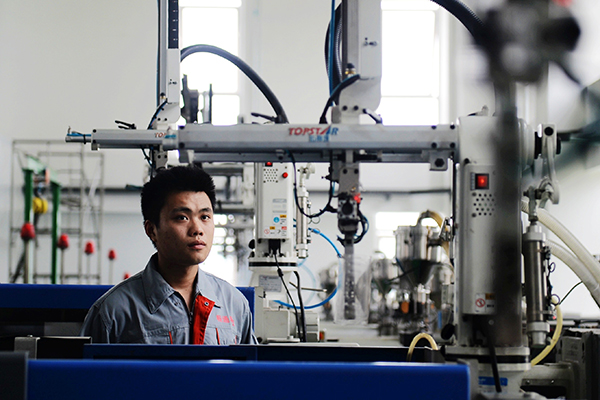 |
|
An employee of a robot manufacturer in Xianghe county, Hebei province, calibrates the robots. [Photo/Xinhua] |
Exports are down in terms of absolute numbers, but China is eating up a larger chunk of the world's shrinking trade pie.
Brushing off rising wages, a shrinking workforce and intensifying competition from lower cost nations from Vietnam to Mexico, China's global export share climbed to 14.6 percent last year from 12.9 percent a year earlier. That's the highest proportion of world exports ever in International Monetary Fund data going back to 1980.
Yet even as its export share climbs globally, manufacturing's slice of China's economy is waning as services and consumption emerge as the new growth drivers. For the global economy, a slide in China's exports this year isn't proving any respite as an even sharper slump in its imports erodes a pillar of demand.
Those trends were replicated in August data that was released on Thursday. In dollar terms, China's exports fell 2.8 percent from a year earlier but imports rose 1.5 percent, leaving a monthly trade surplus of $52.1 billion.
While China's advantage in low-end manufacturing has been seized upon by Donald Trump's populist campaign for the US presidency, the shift into higher value-added products from robots to computers is also pitting China against developed-market competitors from South Korea to Germany. A weaker yuan risks exacerbating global trade tensions, which became a hot-button issue at the G20 meeting in Hangzhou over cheap steel shipments.
"All the talk we have heard over the last few years about China losing its global competitive advantage is nonsense," said Shane Oliver, head of investment strategy at AMP Capital Investors in Sydney. "This will all further fuel increasing trade tensions as already evident in the UK with the Brexit vote and in the US with the support for Trump's populist protectionist platform."
China is also facing opposition to its global shopping spree and calls from bodies such as the European Union Chamber of Commerce in China for improved market access.
A key driver of China's export share gains is its move toward more sophisticated assembly, especially in electronics, which eliminates the need to source components from a vast supply chain across Asia, said Frederic Neumann, co-head of Asian economic research at HSBC Holdings Plc in Hong Kong. That's hurting companies and economies from Singapore to Thailand, Malaysia, China's Taiwan and South Korea, said Neumann.
China is subsidizing higher technology industries including new advanced information technology, robotics, and new energy vehicles under the "Made in China 2025" plan. More is to come as President Xi Jinping's blueprint envisions global competitiveness within a decade in 10 industries from machine tools and robots to advanced railway equipment and medical devices.
China increasingly is turning into an economic competitor as it pushes to produce higher-value exports, said German Chancellor Angela Merkel on a trip to the nation in June. Those words from the leader of China's fifth biggest trade partner pale in comparison with the rhetoric from Trump.
"Political support for open trade and investment is evaporating globally," said David Loevinger, a former China specialist at the US Treasury who is now an analyst at fund manager TCW Group Inc in Los Angeles.
Bloomberg
